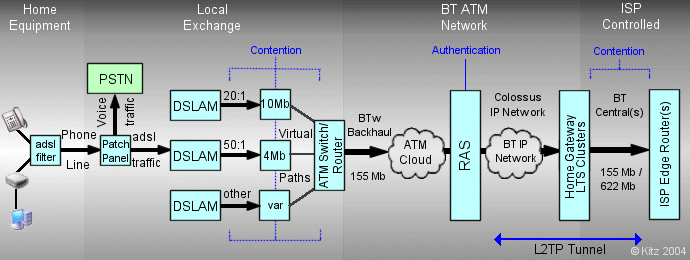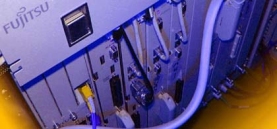 |
|
 |
| Support this site |
| |
|
| |
ADSL - How adsl works - 2 |
||
BT's IPStream Network.
The "pipe" between your local exchange and where it becomes part of the ATM Cloud. The ATM backhaul from the DSLAM/MSAN at the exchange usually consists of a 155Mb pipe, although not all of this 155Mb capacity may be in use. Some small exchanges may be subtended /"piggy backed" to a larger exchange in a nearby town, and as such will have a lesser capacity of 30Mb. It is assumed that these pipes are segmented with various amounts of bandwidth as allocated by the Virtual Path. BT's ATM network between various points, which can take many different
paths/routes. BT's ATM network was originally built in the 1990's to handle traffic for business customers who required such services as intranets on leased lines. Today it also carries IP packets as an ATM stream for internet customers to and from the Colossus backbone. ATM (Asynchronous Transfer Mode) is a networking technology based
on transferring data in cells or packets of a fixed size over a dedicated
connection. In the UK BT uses the networking protocol PPPoA (Point-to-Point Protocol over ATM) over this part of the network for the transmission of data packets. As a side note some other countries (such as the US) use PPPoE (PPP over Ethernet) for adsl.
Location or point where a network can be accessed. - See also Co location
Centre. RAS / B-RAS (Broadband Remote Access Server). Although the RAS could be thought of as a "super exchange"
for adsl, in actual fact it is hardware that is located in strategic
points throughout the UK. In general networking terms the RAS would
be known as a L2TP Access Concentrator (LAC). The RAS is the first major hop of your connection, and it is here
that the login authentication to your ISP is carried out, and you
are allocated your IP address. There are currently 10 RAS's that serve all the various local exchanges:- Due to the way BTw perform their routing, you may find that the RAS that you connect via is not necessarily the nearest to you location wise - its also quite common for different DSLAMs at your exchange to be routed to several different RAS's. Anyone whose ISP uses a BT Central Plus product should be able to see the RAS as their "first hop". Some ISPs however purchase their own central pipes from BT and as such this hop in the routing is hidden. Users with ISPs who have their own centrals may be able to find out which RAS they are connected to by following the instructions here.
Authentication of your adsl connection is carried out at the RAS. The BT RADIUS server authenticates the domain part of the username and from this determines the ISP's Central and associated router. The ISP's RADIUS then authenticates the end user by their username and password. Once both of these have been verified an IP address is assigned to the user. The whole authentication process is actually a lot more complicated, and a more in-depth view can be seen here. RADIUS default timers:- Home gateway router timeout = 10, no of retries =2. SSB (Service Selection Barring) is implemented at
the RAS during the authentication process. When you migrate, BTw will change the SSB details, by removing your old ISP details and inputting your new ISP information so that you can only connect to the new ISP. BT's main Internet Backbone built in the late 1990's to carry IP traffic. It consists of a massive network of fibres and powerful (gigabit) routers which can operate at over a billion bits per second. Every day it carries many GBs of internet traffic around the UK and linking to international internet backbones. (Central Plus ISPs only). The tunnel endpoints on which PPP sessions from the Colossus Network are terminated and where it joins the ISP Central Pipes is known as a home gateway. The Home Gateway is a cluster of LTS's (L2TP Tunnel Switches). The amount of switches required depends upon the size and type of Central Pipe used by the ISP - for example a 155 Mbps Central terminates on 2 LTS' whilst a 622 Mbps pipe will terminate on 12 LTS'. The test login bt_test_user@ispdomain.com is carried out at this level. A BT Central connection provides the link between the ISP's network
and the BT network. A 622Mb central is actually 2 x Gigabit Ethernet Fibre Optic cables
(1000 BaseSX) that terminate on 12 tunnel endpoints (Home gateways/LTS's). A 622Mb central pipe can hold up to a maximum of 25,600 simultaneous
sessions, and can sustain up to 622 Mbit/s of downstream traffic plus
up to 311 Mbit/s upstream throughput. There more in depth information on my BT Centrals Page.
|
All rights reserved
Unauthorised reproduction prohibited
|
|
|
|

